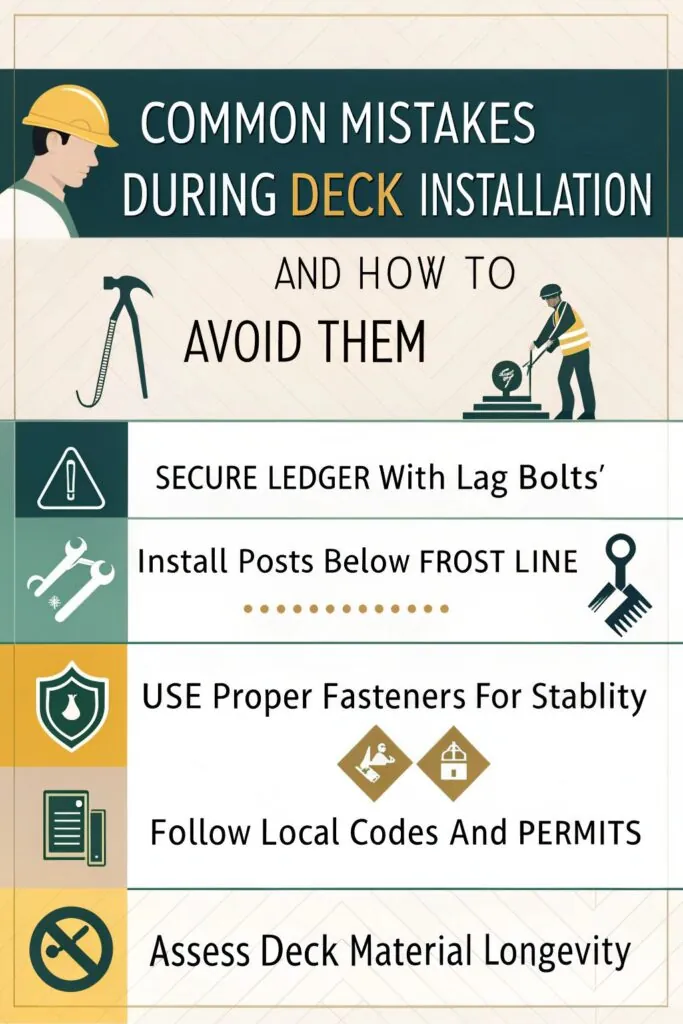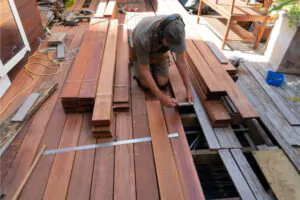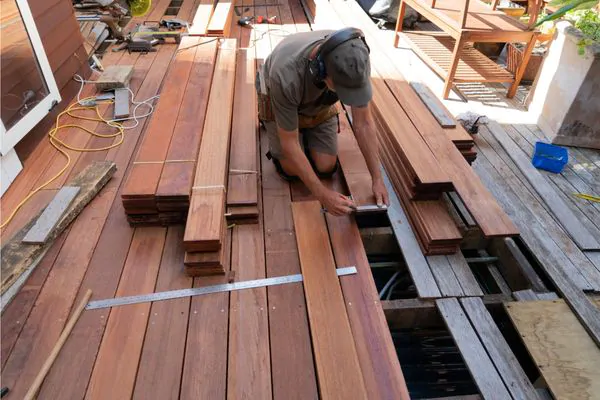Building a deck can be tricky. Many homeowners make mistakes that lead to bad deck construction in their new construction projects. These errors can cause safety issues and costly repairs down the road, especially if they affect the deck ledger. Common problems include wrong ledger board attachment and poor support post installation.
Did you know that using the wrong fasteners can weaken your deck’s structure and lead to serious problems? This is just one of many pitfalls in deck building, particularly when it comes to ensuring the ledger board is properly installed. Our guide will help you avoid these mistakes and build a safe, sturdy deck.
Read on to learn how to create a deck that will last for years to come.
Key Takeaways
- Incorrect ledger board attachment is a major safety risk. Use lag bolts instead of nails and follow local codes to prevent deck collapse.
- Support posts must be installed below the frost line (often 36 inches deep in Colorado) and use concrete footings with metal post bases to avoid rot.
- Proper fasteners are crucial. Use stainless steel or galvanized hardware with pressure-treated lumber to prevent corrosion and ensure deck stability.
- Local building codes and permits are vital. Skipping them can lead to fines, delays, or forced demolition of your deck.
- Cedar decks last 15-20 years with proper care, while composite decking can last up to 25 years. Consult a pro to decide between repairs and replacement, ensuring that your deck must adhere to local building codes.

Top 10 Common Deck Building Mistakes
Deck building mistakes can turn your dream outdoor space into a nightmare. Common errors range from incorrect ledger board attachment to faulty stair construction, potentially compromising safety and longevity.
Incorrect ledger board attachment
Attaching the ledger board wrong is a big mistake in deck building. This board connects your deck to your house and must be strong. Many folks use nails, but that’s not good enough.
Lag bolts are much better for a safe deck. But don’t let improper construction ruin your outdoor experience! If you tighten these bolts too much, you can damage the wood and make them less effective.
Proper ledger board attachment is crucial for deck safety in Colorado. The board needs to be fixed firmly to prevent water damage and rot. Builders should use the right hardware and follow local codes.
A poorly attached ledger can lead to deck collapse, putting people at risk. Always check with experts or city officials to ensure your deck meets all safety standards.
Inadequate support post installation
Support posts form the backbone of your deck. Poor installation can lead to a shaky or unsafe structure, which is why following a comprehensive guide is important. In Colorado, deck footers must go below the frost line to stop frost heave and ensure the deck is capable of supporting seasonal changes.
This depth varies but is often 36 inches or more. Burying treated lumber posts is a no-go. It can cause rot and weaken the deck’s support. Instead, use concrete footings and metal post bases to secure your posts in a way to attach them effectively to the house.
These methods keep the wood above ground and provide solid support.
Proper post sizing matters too. Posts should be thick enough to handle the deck’s weight and any extra loads. For most decks, 6×6 posts work well. Space them no more than 8 feet apart for best support.
Always check local building codes for specific rules. They may require different post sizes or spacing based on your deck’s height and size to ensure it meets building department standards for the deck to your home.
Improper beam-to-post connections
Beam-to-post connections form the backbone of a sturdy deck. Many DIY builders make the mistake of nailing beams directly to posts. This method is unsafe and can lead to deck failure.
The right way involves using Galvanized-steel post caps are often used to secure the deck ledger in place. to seat beams atop support posts. These caps create a strong, lasting bond between the beam and the post.
Proper beam splicing is also crucial for deck stability. Beams should be spliced at the center of post-to-post spans to maintain the integrity of the deck ledger. This ensures even weight distribution and prevents weak points in the deck structure.
Skipping this step can result in a wobbly or sagging deck over time. The next common mistake to watch out for is the incorrect use of fasteners.
Faulty stair construction
Stair building errors can lead to unsafe decks and serious problems if the egress is not properly considered. Deck stairs need careful planning and proper construction to ensure safety and stability. Code R311.7.8.4 requires a continuous handrail for stairs with four or more steps.
This rule helps prevent falls and injuries during the construction process, especially when using a ledger board. The bottom riser height must account for tread thickness, with a max variation of 3/8 inch, to ensure the deck must meet safety standards. Ignoring these rules can result in wobbly or uneven stairs.
Proper stair stringers are key to a solid staircase. Many DIY builders cut corners here, leading to weak stairs. Using the wrong materials or skipping vital supports can cause stairs to sag or break.
Deck builders must follow local building codes and safety standards. Getting the necessary permits ensures your stairs meet all requirements. A professional deck builder can help avoid these common mistakes and create safe, sturdy stairs that are structurally sound.
Incorrect use of fasteners
Fasteners play a crucial role in deck safety. Many DIY builders make the mistake of using the wrong type or size of fasteners. This can lead to weak connections and deck failure, emphasizing the importance of proper hold-down methods. For example, using deck screws instead of proper joist hangers is a common error.
It’s vital to use stainless-steel or galvanized fasteners Using pressure-treated lumber to prevent corrosion is essential when building your deck.
Proper fastener selection ensures your deck stays strong for years, making it capable of supporting heavy loads. Each part of the deck needs specific hardware. Guard posts require bolts and blocking, not just wood screws. Ledger boards must be attached with lag screws or through-bolts.
Using the right fasteners will help your deck pass inspections and avoid costly repairs. Let’s move on to discuss the key principles of deck design and installation.
Neglecting local building codes and permits
Local building codes and permits are vital for deck projects in Colorado to ensure compliance with the building department. Skipping these rules can lead to big problems when building your deck. You might face fines, delays, or even have to tear down your deck.
Most areas require permits for deck building. These rules help keep decks safe and sturdy. They also make sure your deck fits with local laws.
Codes set key rules for deck safety, particularly regarding the installation of the deck ledger to prevent water from seeping. For example, there must be at least 10 feet of space above a deck. The sides need 3 feet of clearance too. These rules protect you from hazards like power lines.
Following codes also helps your deck pass inspections. This saves time and money in the long run.
Deck Design and Installation Principles
Proper deck design starts with a solid plan. A well-made blueprint helps avoid costly mistakes and ensures a safe structure. Key factors include the deck’s size, shape, and height.
These elements affect the materials needed and the building process. Good designs also account for local weather and the home’s style, which can affect the choice of wood decking.
Installing a deck requires careful steps and the right tools. The first task is to set a strong foundation with concrete footings. Next, builders attach the ledger board to the house using lag screws or bolts.
Joists and beams form the frame, which must be level and square. Decking boards go on top, with gaps for water drainage. Railings and stairs are added last for safety and access. Each step needs attention to detail for a long-lasting deck.
How to Avoid Deck Building Mistakes
Avoiding deck building mistakes requires knowledge of proper techniques and materials. Learn more about how to construct a safe and durable deck that meets local building codes.
Understanding proper techniques and materials
Proper deck building starts with knowing the right methods and materials. Use outdoor-rated fasteners and hardware to fight rust and decay. Pick high-quality lumber or composite decking that can stand up to Colorado’s harsh weather.
Follow the maker’s rules when installing composite boards to make your deck last longer. Don’t forget about the frame! A strong understructure is key for a safe deck. Make sure to attach the ledger board correctly to your house.
This vital step keeps your deck from falling away from your home and ensures it is structurally sound.
Consulting professionals and adhering to local regulations
Deck building pros know the ins and outs of local rules. They can help you avoid costly mistakes and ensure your deck is safe. In Colorado, building codes vary by city and county. A pro will guide you through permits and inspections.
They’ll make sure your deck meets all safety standards.
Hiring experts saves time and money in the long run. They’ll use the right materials and techniques for your area. This helps prevent issues like water damage or structural problems that could arise from an improperly built deck.
Pros also stay up-to-date on new decking materials and methods. Their knowledge can lead to a better, longer-lasting deck for your home.
Repairing vs. Replacing Your Deck: What You Need to Know
Deck repairs can save money and extend its life, but sometimes replacement is necessary. Signs of needed repairs include popped nails, cracks, loose railings, and rusted hardware. If you spot these issues, fix them quickly to prevent further damage.
However, widespread rot or an unsound foundation calls for a full deck replacement to ensure the entire deck is safe. Cedar decks last 15-20 years with proper care, while composite decking can serve you for 25 years or more.
Deciding between repair and replacement depends on your deck’s overall condition and age. Small fixes can often solve minor problems, keeping your outdoor space safe and functional.
But if structural issues arise or repairs become frequent, investing in a new deck might be more cost-effective long-term, especially if it is properly attached to the house. Always consult a professional to inspect your deck’s state and recommend the best course of action for your Colorado home.
Tips on Saving Money During Deck Construction
Moving from repair choices to cost-saving tips, smart planning can trim your deck budget. Careful material selection is key. High-quality products may cost more upfront but can save money on future repairs.
Getting multiple quotes from contractors helps find the best price. Doing some work yourself, like staining or sealing, cuts labor costs and can be a part of a comprehensive guide to maintaining your deck. Buying materials in bulk or during sales periods can lead to big savings.
Simple designs often cost less than complex ones. Proper planning prevents costly mistakes and redos. These steps can help you build a great deck without breaking the bank.
Conclusion
Building a deck takes skill and care to ensure it is structurally sound. Mistakes can lead to unsafe structures and costly repairs. Smart planning and following local codes help avoid common errors when building your deck. Hiring a pro or learning proper techniques ensures a solid, long-lasting deck.
With the right approach, you’ll create a safe outdoor space for years of enjoyment.
FAQs
1. What are common mistakes in deck-building?
Common deck-building mistakes include improper attachment to the house, poor ventilation, and incorrect joist spacing. These errors can lead to safety issues and structural problems. Builders often fail to use proper connectors or follow installation instructions, resulting in a poorly built deck.
2. How can I ensure my deck is built properly?
To build a deck properly, follow building codes and get permits. Use the right materials, like stainless steel fasteners, pressure-treated lumber, and wood decking for durability. Install a proper ledger board and flashing to prevent water damage. Seek help from professionals if needed, and have your work checked by an inspector.
3. Why is proper attachment to the house important?
Proper attachment to the house is crucial for deck safety. The ledger board must be securely fastened to prevent collapse. Use lag bolts or through-bolts, not just nails. Install flashing to keep water out. This prevents wood rot and ensures your deck remains an extension of your home.
4. What role does ventilation play in deck construction?
Ventilation is key in deck construction. It helps prevent wood decay and extends the life of your deck, especially when using composite decking materials. Leave gaps between deck boards for airflow. For low decks, use lattice or vents in the framing. Good ventilation keeps the wood dry and reduces the risk of fungal growth.
5. How do I avoid issues with deck joists?
To avoid joist problems, use the correct size and spacing as per building codes and construction to ensure safety. Don’t notch floor joists, as this weakens them. Use joist hangers and secure them properly. For longer spans, consider using larger joists or adding support beams. This ensures your deck frame is strong and durable.
6. What should I know about guard rails for decks?
Guard rails are a must for decks above a certain height. They should be sturdy and meet local building codes. Use proper fasteners and ensure they can withstand the required loads. Don’t attach railings to deck boards alone; secure them to the framing. This prevents accidents and ensures your outdoor living space is safe.









